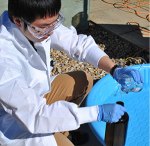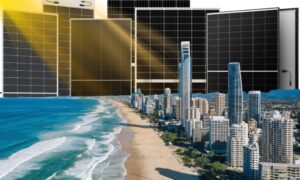Researchers from the University of Alberta have developed a solar energy-driven technique for removing dangerous contaminants from oil sands tailings, the toxic liquid remains of shale oil production.
They say the process, which uses sunlight instead of UV lamps to break down dangerous chemicals in oil sands process affected water (OSPW) retained in tailings ponds, could vastly accelerate pond reclamation efforts by Canada’s refining industry at a much lower cost.
“This alternative process not only addresses the need for managing these tailings ponds, but it may further be applied to treat municipal wastewater as well. Being a solar-driven process, the cost would be minimal compared to what’s being used in the field now,” said Professor Mohamed Gamal El-Din, of UA’s Department of Civil and Environmental Engineering.
OSPW describes water that has been in contact with oil sands or released from tailings deposits near refining sites. A complex mixture of suspended solids, salts, inorganic compounds, dissolved organic compounds, and trace metals; OSPW also contains thousands of as yet unidentified compounds called naphthenic acids (NAs), which have been reported to cause both acute and chronic toxicity to fish, amphibians and mammals.
The Alberta team’s reclamation process utilises solar UV to destroy organic contaminants in the OSPW along with a chlorine solution which reacts with sunlight to produce a powerful oxidising radical that effectively wipes out remaining any toxins.
Leftover chlorine then rapidly decomposes in the sun. According laboratory results, the technique was found to remove 75 to 84 per cent of toxic chemicals in contaminated wastewater.
“Typically, these tailings ponds take 20 plus years before they can be reclaimed. The solar UV/chlorine treatment process when applied to the tailings ponds would make OSPW decontamination and detoxification immediate,” a UA release said.
Gamal El-Din said the project has already attracted industry attention and the team are seeking funds to commercialise the technology.
“Because we are limited by the sunlight’s penetration of the water, we now must come up with an innovative design for a mixing system like rafts floating on the ponds that would circulate the water. Installing this would still be much more cost effective for companies. It is expected that the UV/chlorine process will treat the OSPW to the point that the effluent can be fed to a municipal wastewater treatment plant, which will then complete the purification process sufficiently so the water can be discharged safely into rivers.”
Of course, a much more environmentally friendly approach would be to cease tar sands oil extraction altogether. But that, on top of being highly unlikely, still wouldn’t fix the damage already done – which is where better reclamation processes would still be highly desirable.














































